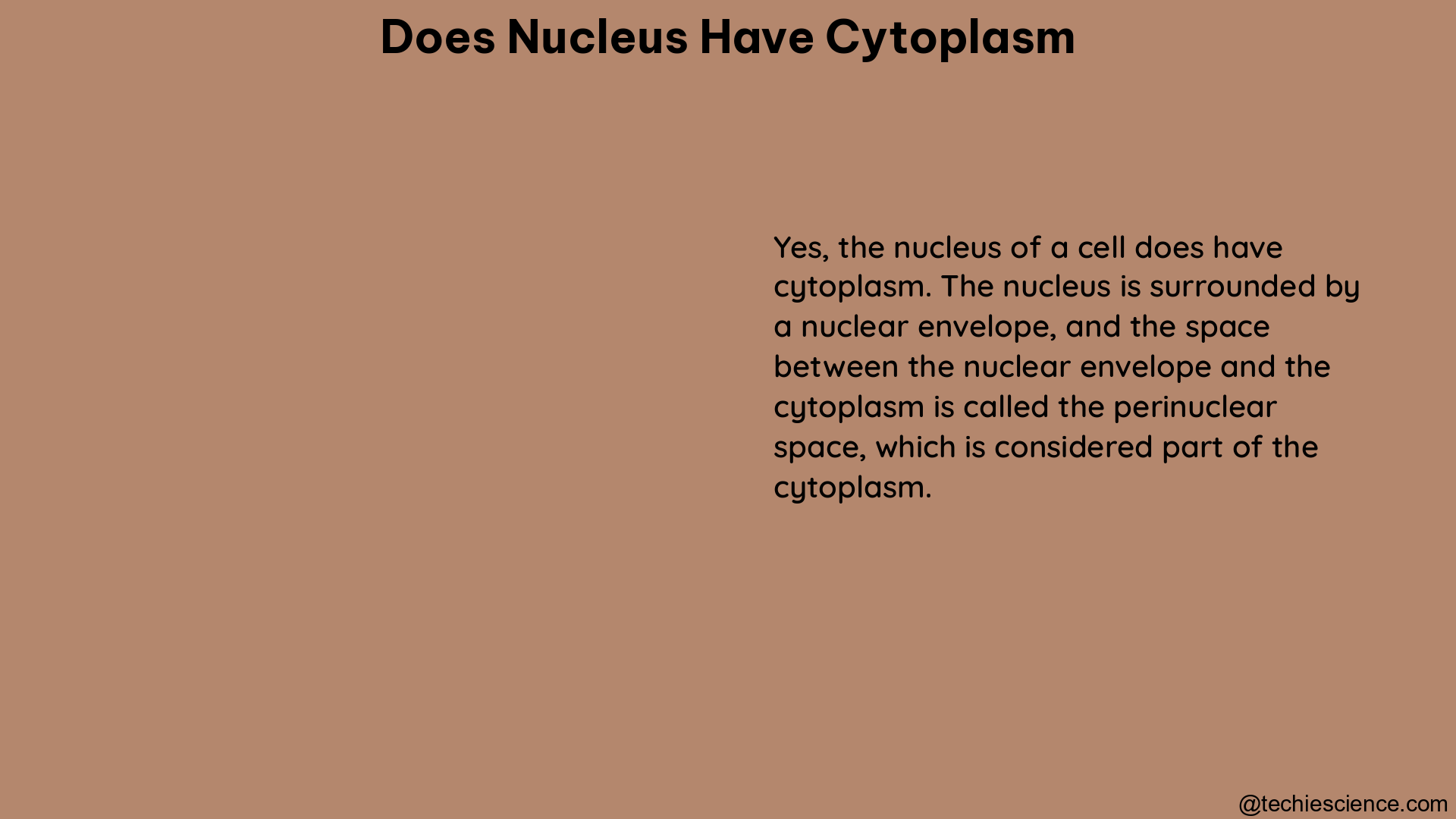The nucleus, a vital organelle within eukaryotic cells, is often misunderstood to contain cytoplasm. However, the reality is quite different. The nucleus does not have cytoplasm within it; instead, the cytoplasm is the material that surrounds the nucleus and fills the rest of the cell. This distinction is crucial in understanding the structure and function of the cell.
The Nucleus: The Control Center of the Cell
The nucleus is the command center of the eukaryotic cell, responsible for housing the genetic material and controlling the cell’s activities. It is a membrane-bound organelle that is typically the largest and most prominent structure within the cell. The nucleus is composed of several key components, including the nuclear envelope, the nucleoplasm, and the nucleolus.
The nuclear envelope is a double-layered membrane that separates the nucleus from the cytoplasm. This envelope is perforated by nuclear pores, which allow the controlled exchange of materials between the nucleus and the cytoplasm.
The nucleoplasm is the fluid-like substance that fills the interior of the nucleus. It is composed of water, proteins, and other molecules, and it serves as the medium in which the genetic material, in the form of DNA, is stored and processed.
The nucleolus is a dense, specialized region within the nucleoplasm that is responsible for the production of ribosomes, the cellular organelles that are essential for protein synthesis.
The Cytoplasm: The Cellular Matrix

The cytoplasm, on the other hand, is the material that fills the space between the cell membrane and the nucleus, as well as the space within the cell’s organelles. It is a complex, jelly-like substance that is primarily composed of water, salts, and a variety of proteins, including enzymes, structural proteins, and signaling molecules.
The cytoplasm serves as the cellular matrix, providing the necessary environment for the various organelles and cellular processes to function. It is within the cytoplasm that many of the cell’s essential activities, such as metabolism, protein synthesis, and organelle movement, take place.
The Relationship Between the Nucleus and the Cytoplasm
While the nucleus and the cytoplasm are distinct and separate compartments within the eukaryotic cell, they are closely interconnected and interdependent. The nucleus is responsible for controlling the cell’s activities by regulating gene expression and directing the synthesis of various proteins. These proteins are then transported out of the nucleus and into the cytoplasm, where they can carry out their designated functions.
Conversely, the cytoplasm provides the necessary resources and environment for the nucleus to function effectively. The cytoplasm supplies the nucleus with the raw materials, energy, and signaling molecules that it needs to carry out its tasks.
Measuring the Nucleus-to-Cytoplasm Ratio
In the context of cell biology, the ratio of the nucleus to the cytoplasm (N/C ratio) is an important metric that can provide valuable insights into the cell’s physiological state and function.
The N/C ratio is calculated by measuring the relative sizes or volumes of the nucleus and the cytoplasm within a cell. This ratio can vary depending on the cell type, the stage of the cell cycle, and the cell’s metabolic activity.
Accurately measuring the N/C ratio can be challenging, especially when dealing with images of cells that have significant background noise or when the cells are not stained. In such cases, advanced image analysis techniques, such as pixel classification in ilastik or Trainable Weka Segmentation in FIJI, can be helpful in accurately distinguishing the cells from the background and the nucleus from the cytoplasm.
Once the cells and nuclei have been accurately segmented, the N/C ratio can be calculated by dividing the area or intensity of the nucleus by the area or intensity of the cytoplasm. This ratio can provide valuable information about the distribution of proteins and other molecules within the cell, as well as insights into the regulation of cellular processes.
The Importance of Understanding the Nucleus-Cytoplasm Relationship
Understanding the relationship between the nucleus and the cytoplasm is crucial in the field of cell biology. This knowledge not only helps us to better understand the structure and function of eukaryotic cells but also has important implications in various areas of research and application, such as:
-
Cell Physiology: The N/C ratio can be used as an indicator of a cell’s metabolic activity, proliferation, and differentiation status, which can be important in the study of various biological processes and diseases.
-
Cancer Biology: Changes in the N/C ratio have been observed in cancer cells, and this metric can be used as a diagnostic tool to detect and monitor the progression of certain types of cancer.
-
Developmental Biology: The N/C ratio can vary during different stages of embryonic development, providing insights into the regulation of cellular processes and the differentiation of stem cells.
-
Regenerative Medicine: Understanding the relationship between the nucleus and the cytoplasm can inform the development of cell-based therapies and the optimization of cellular reprogramming techniques.
-
Biotechnology: The N/C ratio can be a valuable parameter in the optimization of cell culture conditions and the production of recombinant proteins or other biomolecules.
In conclusion, the nucleus does not contain cytoplasm within it; rather, the cytoplasm is the material that surrounds the nucleus and fills the rest of the eukaryotic cell. Understanding this fundamental distinction is crucial in the study of cell biology and has important implications in various fields of research and application.
References:
- Measuring the nucleus-to-cytoplasm ratio of a cell in an image with significant background noise
- Quantitative analysis of the nucleus-to-cytoplasm ratio in Drosophila embryos at the cellular blastoderm stage
- Cytoplasm
- What is the Nucleus?
- Cytoplasm and Organelles
Hi, I am Sayantani Mishra, a science enthusiast trying to cope with the pace of scientific developments with a master’s degree in Biotechnology.